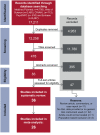Evaluating the Impact of Orthostatic Syncope and Presyncope on Quality of Life: A Systematic Review and Meta-Analysis
- PMID: 35224062
- PMCID: PMC8866568
- DOI: 10.3389/fcvm.2022.834879
Evaluating the Impact of Orthostatic Syncope and Presyncope on Quality of Life: A Systematic Review and Meta-Analysis
Abstract
Purpose: Syncope (transient loss of consciousness and postural tone) and presyncope are common manifestations of autonomic dysfunction that are usually triggered by orthostasis. The global impact of syncope on quality of life (QoL) is unclear. In this systematic review, we report evidence on the impact of syncope and presyncope on QoL and QoL domains, identify key factors influencing QoL in patients with syncopal disorders, and combine available data to compare QoL between syncopal disorders and to population normative data.
Methods: A comprehensive literature search of academic databases (MEDLINE (PubMed), Web of Science, CINAHL, PsycINFO, and Embase) was conducted (February 2021) to identify peer-reviewed publications that evaluated the impact of vasovagal syncope (VVS), postural orthostatic tachycardia syndrome (POTS), or orthostatic hypotension (OH) on QoL. Two team members independently screened records for inclusion and extracted data relevant to the study objectives.
Results: From 12,258 unique records identified by the search, 36 studies met the inclusion criteria (VVS: n = 20; POTS: n = 13; VVS and POTS: n = 1; OH: n = 2); 12 distinct QoL instruments were used. Comparisons of QoL scores between patients with syncope/presyncope and a control group were performed in 16 studies; significant QoL impairments in patients with syncope/presyncope were observed in all studies. Increased syncopal event frequency, increased autonomic symptom severity, and the presence of mental health disorders and/or comorbidities were associated with lower QoL scores.
Conclusion: This review synthesizes the negative impact of syncope/presyncope on QoL and identifies research priorities to reduce the burden of these debilitating disorders and improve patient QoL.
Keywords: carotid sinus hypersensitivity; orthostatic hypotension; postural orthostatic tachycardia syndrome (POTS); quality of life; vasovagal syncope.
Copyright © 2022 Hockin, Heeney, Whitehurst and Claydon.
Conflict of interest statement
The authors declare that the research was conducted in the absence of any commercial or financial relationships that could be construed as a potential conflict of interest.
Figures




Similar articles
-
Salt supplementation in the management of orthostatic intolerance: Vasovagal syncope and postural orthostatic tachycardia syndrome.Auton Neurosci. 2022 Jan;237:102906. doi: 10.1016/j.autneu.2021.102906. Epub 2021 Nov 11. Auton Neurosci. 2022. PMID: 34823150 Review.
-
A comparison of health-related quality of life in autonomic disorders: postural tachycardia syndrome versus vasovagal syncope.Clin Auton Res. 2021 Jun;31(3):433-441. doi: 10.1007/s10286-021-00781-x. Epub 2021 Feb 7. Clin Auton Res. 2021. PMID: 33550497 Free PMC article.
-
Sympathetic dysfunction in vasovagal syncope and the postural orthostatic tachycardia syndrome.Front Physiol. 2014 Jul 28;5:280. doi: 10.3389/fphys.2014.00280. eCollection 2014. Front Physiol. 2014. PMID: 25120493 Free PMC article. Review.
-
[Co-morbidity of vasovagal syncope and postural tachycardia syndrome with allergic diseases in children].Beijing Da Xue Xue Bao Yi Xue Ban. 2017 Oct 18;49(5):783-788. Beijing Da Xue Xue Bao Yi Xue Ban. 2017. PMID: 29045956 Chinese.
-
Autonomic dysfunction presenting as postural orthostatic tachycardia syndrome in patients with multiple sclerosis.Int J Med Sci. 2010 Mar 11;7(2):62-7. doi: 10.7150/ijms.7.62. Int J Med Sci. 2010. PMID: 20309394 Free PMC article.
Cited by
-
Orthostatic Hypotension in Benign Prostatic Hyperplasia Patients and Its Association With Alpha-1 Antagonist Use: A Comprehensive Literature Review.Cureus. 2023 Aug 25;15(8):e44097. doi: 10.7759/cureus.44097. eCollection 2023 Aug. Cureus. 2023. PMID: 37750139 Free PMC article. Review.
-
Faintly tired: a systematic review of fatigue in patients with orthostatic syncope.Clin Auton Res. 2022 Jun;32(3):185-203. doi: 10.1007/s10286-022-00868-z. Epub 2022 Jun 10. Clin Auton Res. 2022. PMID: 35689118 Free PMC article.
-
Trazodone and Risk of Orthostatic Hypotension, Syncope and Falls in Geriatric Outpatients with Hypertension.Drugs Aging. 2025 Apr;42(4):373-380. doi: 10.1007/s40266-025-01196-3. Epub 2025 Mar 11. Drugs Aging. 2025. PMID: 40067602 Free PMC article.
-
Exaggerated postural sway improves orthostatic cardiovascular and cerebrovascular control.Front Cardiovasc Med. 2023 Feb 16;10:1040036. doi: 10.3389/fcvm.2023.1040036. eCollection 2023. Front Cardiovasc Med. 2023. PMID: 36873416 Free PMC article.
-
Poor health-related quality of life in postural orthostatic tachycardia syndrome in comparison with a sex- and age-matched normative population.Clin Auton Res. 2023 Aug;33(4):469-477. doi: 10.1007/s10286-023-00955-9. Epub 2023 Jun 20. Clin Auton Res. 2023. PMID: 37338634 Free PMC article.
References
Publication types
LinkOut - more resources
Full Text Sources
Miscellaneous

